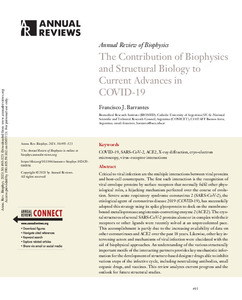Por favor, use este identificador para citar o enlazar este ítem:
https://repositorio.uca.edu.ar/handle/123456789/14239| Campo DC | Valor | Lengua/Idioma |
|---|---|---|
| dc.contributor.author | Barrantes, Francisco José | es |
| dc.date.accessioned | 2022-06-23T15:35:19Z | - |
| dc.date.available | 2022-06-23T15:35:19Z | - |
| dc.date.issued | 2021 | - |
| dc.identifier.citation | Barrantes, F.J. The contribution of biophysics and structural biology to current advances in COVID-19 [en línea]. Annual Review of Biophysics. 2021, 50 doi:10.1146/annurev-biophys-102620-080956 Disponible en: https://repositorio.uca.edu.ar/handle/123456789/14239 | es |
| dc.identifier.issn | 1936-122X | - |
| dc.identifier.uri | https://repositorio.uca.edu.ar/handle/123456789/14239 | - |
| dc.description.abstract | Abstract: Critical to viral infection are the multiple interactions between viral proteins and host-cell counterparts. The first such interaction is the recognition of viral envelope proteins by surface receptors that normally fulfil other physiological roles, a hijacking mechanism perfected over the course of evolution. Severe acute respiratory syndrome coronavirus 2 (SARS-CoV-2), the etiological agent of coronavirus disease 2019 (COVID-19), has successfully adopted this strategy using its spike glycoprotein to dock on the membraneboundmetalloprotease angiotensin-converting enzyme 2 (ACE2). The crystal structures of several SARS-CoV-2 proteins alone or in complex with their receptors or other ligands were recently solved at an unprecedented pace. This accomplishment is partly due to the increasing availability of data on other coronaviruses and ACE2 over the past 18 years. Likewise, other key intervening actors and mechanisms of viral infection were elucidated with the aid of biophysical approaches. An understanding of the various structurally important motifs of the interacting partners provides key mechanistic information for the development of structure-based designer drugs able to inhibit various steps of the infective cycle, including neutralizing antibodies, small organic drugs, and vaccines. This review analyzes current progress and the outlook for future structural studies. | es |
| dc.format | application/pdf | es |
| dc.language.iso | eng | es |
| dc.publisher | Annual Reviews | es |
| dc.rights | info:eu-repo/semantics/closedAccess | * |
| dc.rights.uri | http://creativecommons.org/licenses/by-nc-sa/4.0/ | * |
| dc.source | Annual Review of Biophysics. 2021, 50 | es |
| dc.subject | COVID-19 | es |
| dc.subject | PROTEINAS | es |
| dc.subject | ESTRUCTURA MOLECULAR | es |
| dc.subject | BIOFISICA | es |
| dc.subject | BIOLOGIA | es |
| dc.title | The contribution of biophysics and structural biology to current advances in COVID-19 | es |
| dc.type | Artículo | es |
| dc.identifier.doi | 10.1146/annurev-biophys-102620-080956 | - |
| dc.identifier.pmid | 33957057 | - |
| uca.disciplina | MEDICINA | es |
| uca.issnrd | 1 | es |
| uca.affiliation | Fil: Barrantes, Francisco José. Pontificia Universidad Católica Argentina. Facultad de Ciencias Médicas. Instituto de Investigaciones Biomédicas; Argentina | es |
| uca.affiliation | Fil: Barrantes, Francisco José. Consejo Nacional de Investigaciones Científicas y Técnicas; Argentina | es |
| uca.version | publishedVersion | es |
| item.grantfulltext | mixedopen | - |
| item.fulltext | With Fulltext | - |
| item.languageiso639-1 | en | - |
| crisitem.author.dept | Instituto de Investigaciones Biomédicas - BIOMED | - |
| crisitem.author.dept | Laboratorio de Neurobiología Molecular | - |
| crisitem.author.dept | Facultad de Ciencias Médicas | - |
| crisitem.author.orcid | 0000-0002-4745-681X | - |
| crisitem.author.parentorg | Facultad de Ciencias Médicas | - |
| crisitem.author.parentorg | Instituto de Investigaciones Biomédicas - BIOMED | - |
| crisitem.author.parentorg | Pontificia Universidad Católica Argentina | - |
| Aparece en las colecciones: | Artículos | |
Ficheros en este ítem:
| Fichero | Descripción | Tamaño | Formato | Login |
|---|---|---|---|---|
| contribution-biophysics-structural.pdf | 5,51 MB | Adobe PDF | SOLICITAR ACCESO | |
| thumb.pdf | 128,29 kB | Adobe PDF |  Visualizar/Abrir |
Visualizaciones de página(s)
81
comprobado en 27-abr-2024
Descarga(s)
23
comprobado en 27-abr-2024
Google ScholarTM
Ver en Google Scholar
Altmetric
Altmetric
Este ítem está sujeto a una Licencia Creative Commons

